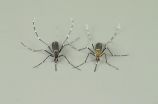Those are among the findings of a paper co-authored by David Tilman, a professor in the Bren School of Environmental Science & Management, and Michael Clark, a graduate student at the University of Minnesota, where Tilman also is a professor. In "Global Diets Link Environmental Sustainability and Human Health," published today in the journal Nature, the researchers find that rising incomes and urbanization around the world are driving a global dietary transition that is, in turn, diminishing the health of both people and the planet.
"These dietary shifts," they write, "are greatly increasing the incidence of Type 2 diabetes, coronary heart disease and other chronic non-communicable diseases that lower global life expectancies."
The paper is the first to show the global links among the elements of what Tilman refers to as the "tightly linked diet-environment-health trilemma."
"Previous analyses have looked at the effects of diet in individual countries, but we are the first to examine the global impacts on both human health and the environment of diet as it is now and as it is becoming," he says. "We gathered information on dietary trends and environmental impacts for 90 percent of the global population. Our data let us see how diets, health and the environment have been changing and where they are going."
"Some of what we found is not surprising, but the global implications are frightening," Tilman adds. "Most of us have heard that some diets are healthier, that eating too many calories is bad for you and that red meat harms the environment. We were surprised at how rapidly and consistently diets were changing around the world, how massively this would impact global health and how much it would increase global greenhouse gas emissions and the destruction of tropical forests and other ecosystems."
Unhealthful Diets Linked to Urbanization
The links between urbanization, increased wealth and unhealthful diets are clear, Tilman explains. When a country industrializes, the transition from a traditional rural diet to one that includes more processed meats and more empty calories can occur quickly. "People move to cities, leaving behind their own gardens where they grew fruits and vegetables," Tilman said. "They're working in a factory 12 hours a day, six or seven days a week, so they need food that's cheap and fast. The cheapest, fastest food you can get is filled with starch, sugar, fat and salt. Almost overnight, they go from a healthy diet to one that has way too many calories and leads to diabetes and heart disease."
Also, because people tend to eat more meat as they become wealthier, much of the expected 100-percent increase in crop production that will be required by 2050 would be used to feed not humans but livestock. To do that, much more land will need to be cleared, with the result that more habitat will be lost, more species will likely become extinct and increased runoff of agricultural fertilizers and pesticides will degrade streams, rivers, lakes, groundwater and oceans.
Alternative Diets Offers Health Benefits
Tilman suggests that hope -- and help -- lie in the widespread adoption of alternative diets that offer substantial health benefits and could reduce global agricultural greenhouse gas emissions, reduce land clearing and resultant species extinctions and help prevent a variety of diet-related chronic noncommunicable diseases.
Comparing conventional American omnivorous diets to the Mediterranean diet, a pescetarian diet (in which fish is the only animal protein) and a vegetarian diet, the compiled research showed that the three alternatives to the omnivorous diet decreased Type 2 diabetes by 16 to 41 percent, cancer by 7 to 13 percent and morality rates from coronary heart disease by 20 to 26 percent. Moreover, the authors show that these alternative diets could reduce global greenhouse gas emissions from food production by about 40 percent below what they would be if dietary trends continued.
To reach their conclusions, the researchers gathered all published life-cycle assessments covering "cradle to farm gate" greenhouse gas emissions for production systems of food crops, livestock, fisheries and aquaculture -- some 500 studies, of which about 220 were useful. They also gathered 50 years of data for 100 of the world's more populous nations to analyze global dietary trends and their drivers, using that information to forecast future diets should past trends continue.
To quantify the effects of alternative diets on mortality and on Type 2 diabetes, cancer and chronic coronary heart disease, they summarized results of eight major long-term studies on diet and health. Finally, they combined those relationships with projected increases in global population to forecast global environmental implications of current dietary trajectories and calculate the environmental benefits of diets associated with reduced rates of chronic noncommunicable diseases.
"Better diets are the solution to these big problems," Tilman says. "Only better diets can prevent a massive global epidemic of chronic noncontagious disease. These same diets would also protect the environment. Since big food companies produce so much of what is eaten, we need them to be part of this solution. By developing, producing and advertising foods that are healthy and tasty, these companies can help their customers, the earth and their bottom line. It is a niche waiting to be filled."
Tilman wonders if unhealthy foods laden with fats or sugars might grow into a health issue somewhat like smoking. "Throughout history, foods that tasted good were almost always healthy but scarce. Now we have thousands of inexpensive manufactured foods that taste good because of an overabundance of sugar, fat or salt but are bad for us. What is the ethics of selling such foods now that we know how bad they are for heath and the environment?"
The research generated a number of nuanced findings about the environmental impacts of various dietary choices. The following are among them:
While the difference in greenhouse gas emissions for animal-based versus plant-based foods is well known, emissions per gram of protein for beef and lamb are about 250 times those of legumes; pork, chicken, dairy, and fish have much lower emissions;
Twenty servings of vegetables have fewer greenhouse gas emissions than one serving of beef.
Fish caught by trawling, which involves dragging fishnets along the ocean floor, can have three times the emissions of fish caught by traditional methods.
And among cereal grains, rice has five times the emissions per gram of protein as wheat.
These and other facts demonstrate that there are many diets that are both good for the environment and healthy.
While Tilman does not expect to see quick societal changes in diet, he hopes that the paper will be seen by the right people who can influence the food supply and that it "can encourage people to think about this challenge and have a dialogue it."
INFORMATION:

